Physical Address
304 North Cardinal St.
Dorchester Center, MA 02124
Non-lymphoid elements are frequently present in surgically excised lymph nodes. This chapter reviews the most commonly encountered tumors and non-neoplastic lesions, especially those that can mimic lymphoma, and provides an update on studies useful in distinguishing them. The chapter begins with lymph node metastases because they can present the most diagnostic difficulty and also describes the range of non-neoplastic inclusions included in the differential diagnosis of metastatic tumors. Then mesenchymal and vascular proliferations are discussed, including those that are intrinsic to the lymph node.
The identification of metastatic solid tumors in lymph nodes is one of the most important tasks in diagnostic surgical pathology. Up to 5% of cancer patients present with lymph node metastasis from an occult primary tumor. Most of these neoplasms are carcinomas; however, 2% of patients with melanoma and a smaller percentage of patients with germ cell tumors and sarcomas may initially present with lymph node metastasis. In this section, we review the histologic features and ancillary tests that can be performed on a metastatic tumor to identify its site of origin.
Most solid tumors metastasize to regional lymph nodes following invasion of peritumoral lymphatics, with sequential progression down the lymphatic chain. As a result, metastatic deposits in lymph nodes are initially located preferentially in the extranodal vessels and subcapsular sinuses. This localization pattern is diagnostically useful because it is uncommon in lymphoma, with the exception of anaplastic large-cell lymphoma. More extensive metastatic involvement is usually multifocal or geographic, but there is often a discrete boundary separating the tumor from uninvolved areas of lymph node. Often tumor nests or extranodal large vessel invasion in fat may be associated with a lymphoid response and mimic a lymph node, so attention to the presence of a capsule or subcapsular sinus, and a circumscribed versus stellate appearance can be useful. Metastatic solid tumors usually have a cohesive appearance, forming sheets, nests, or islands; undifferentiated carcinoma and melanoma may have a discohesive appearance, mimicking lymphoma.
Histologic clues to the site of origin of a metastatic tumor include keratinization or mucin production in carcinomas, rosette formation in neuroendocrine tumors, melanin pigment in melanomas, and abundant extracellular matrix or a fibrillary-filamentous cytoplasmic appearance in sarcomas. Metastatic papillary tumors of the thyroid gland, kidney, ovary, or lung can show nuclear pseudoinclusions and psammoma bodies; carcinomas of lung and prostate origin often show evidence of partial neuroendocrine differentiation; and foci of necrosis (often with admixed neutrophils and debris) are common in colon adenocarcinoma. Cytochemical stains for mucin, neurosecretory granules (e.g., Grimelius and Fontana), or extracellular matrix proteins (e.g., reticulin and Masson trichrome) have largely been replaced by immunohistochemistry in routine diagnosis.
Poorly differentiated metastatic tumors are common and can be classified preliminarily as epithelioid, anaplastic, spindled, or small cell ( Fig. 59-1 ). Table 59-1 outlines the differential diagnosis of metastatic tumors in each of these morphologic categories. Because of their relatively small cell size and discohesive growth, small-cell tumors are among the most difficult to detect and distinguish from lymphoma; in some instances, immunohistochemistry is required for diagnosis. Lobular carcinoma of the breast ( Fig. 59-2 ), carcinoid tumor, small-cell carcinoma, Merkel cell carcinoma, and neuroblastoma can all show subtle infiltration of the interfollicular nodal areas. Colonization of lymphoid follicles is also occasionally observed. In the mediastinum, occult lung metastasis of small-cell carcinoma can mimic lymphoblastic lymphoma but typically shows more prominent nuclear molding. Small-cell carcinomas of the lung also commonly have abundant coagulative necrosis and basophilic deposition of DNA within blood vessels (known as nuclear encrustation or the Azzopardi phenomenon). Zonal areas of necrosis may also be seen in neuroblastoma. Although rare, rhabdomyosarcoma ( Fig. 59-3 ) and primitive neuroectodermal tumor/Ewing's sarcoma ( Fig. 59-4 ) can both show subtle interfollicular infiltration of the lymph node and should be considered in younger patients.
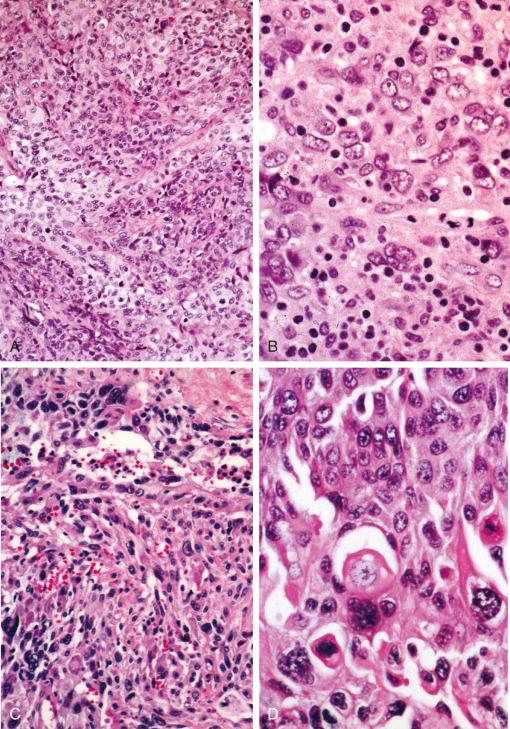
| Histologic Pattern | Tumor Types | Useful Diagnostic Tests and Clues |
|---|---|---|
| Small-cell tumors | Carcinoma (lobular breast, prostate) | Keratin |
| Small-cell, Merkel cell carcinoma | Chromogranin; keratin can be focal | |
| Neuroendocrine, carcinoid tumors | Chromogranin, synaptophysin, CD56 | |
| Neuroblastoma | NSE, neurofilament, NB84, EM | |
| Lymphoblastic lymphoma | TdT, cytogenetics | |
| Ewing's sarcoma, other primitive sarcomas | PAS stain, CD99, Fli-1, NKX2-2, cytogenetics | |
| Rhabdomyosarcoma | Desmin, myogenin, Myo D1 EM, cytogenetics | |
| Epithelioid tumors | Carcinoma (especially renal cell, prostate, breast) | Multiple keratin stains/cocktails often helpful |
| Melanoma | S-100, HMB45, tyrosinase, MART-1 | |
| Large-cell lymphoma | CD45/LCA, CD3, CD20 | |
| Seminoma (especially retroperitoneum, mediastinum) | PLAP, PAS stain, Oct-4, SALL4, LIN28 | |
| Extramedullary myeloid cell tumor | Myeloperoxidase, lysozyme, CD34, CD43, CD68, CD117/c-KIT | |
| Plasma cell myeloma | CD138, CD38, immunoglobulins | |
| Anaplastic tumors | Carcinoma (lung, bladder, breast, thyroid gland) | Focal keratinization or mucin |
| Nasopharyngeal carcinoma | Epstein-Barr virus in situ hybridization | |
| Melanoma | S-100, HMB45, melan A, tyrosinase | |
| Anaplastic large-cell lymphoma | CD30, EMA, ALK, CD43 (often CD3 − ) | |
| Hodgkin's lymphoma | CD15, CD30 (CD45/LCA − ), MUM1, PAX5 | |
| Dendritic cell neoplasms | CD21 (FDC), S-100 (IDC), EM | |
| Angiosarcoma | CD31, CD34, factor VIII–related antigen, ERG | |
| Leiomyosarcoma | Desmin (actins are less specific), EM | |
| Spindle cell tumors | Sarcomatoid carcinoma | Keratins, especially HMW (often only focally positive) |
| Desmoplastic melanoma | S-100 (HMB45 and MART-1 often negative) | |
| Kaposi's sarcoma | PAS, CD34, HHV-8 LNA-1, podoplanin | |
| Large-cell lymphoma with fibrosis (especially mediastinal) | CD20 (works in necrotic tumor areas as well), PAX5 | |
| Syncytial variant of Hodgkin's disease | CD15, CD30 (CD43 − , CD45/LCA − ) | |
| FDC neoplasms | CD21, CD35 (CD23 can be negative) | |
| Metastatic sarcoma (especially angiosarcoma, nerve sheath tumors, or myofibroblastic sarcoma) | EM and cytogenetics helpful | |
| Inflammatory pseudotumor | Admixed acute inflammatory cells, smooth muscle actin, ALK1 | |
| Infectious pseudotumor | AFB, fungal, and Gram stains |
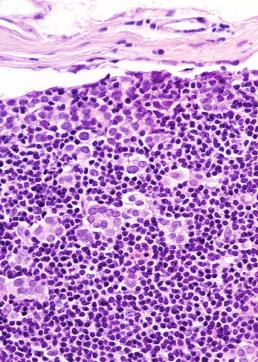
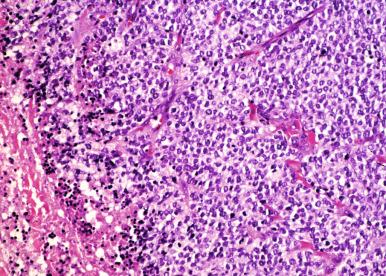
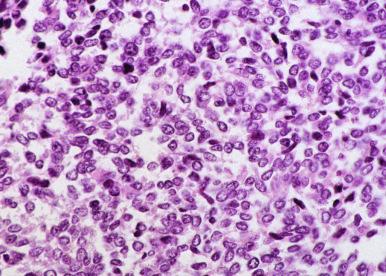
Among epithelioid tumors, metastatic carcinoma and melanoma are the most common non-hematopoietic tumors encountered. Metastatic seminoma ( Fig. 59-5 ) should be considered, particularly in retroperitoneal lymph nodes. Large-cell lymphomas can also appear cohesive and need to be excluded. Anaplastic tumors presenting in a lymph node have a broad differential diagnosis and can show abnormal antigen-expression patterns. In addition, antigen shedding from infiltrating lymphoid cells or histiocytes can mistakenly make the undifferentiated tumor appear to be positive for leukocyte markers. Thus, careful attention to cytoplasmic features is helpful. For example, focal mucin droplets can be present in poorly differentiated adenocarcinoma, intracellular lumens can be seen in vascular tumors, and so-called hallmark cells may suggest anaplastic large-cell lymphoma, but similar cells can be seen in other anaplastic tumors, such as anaplastic thyroid carcinoma.
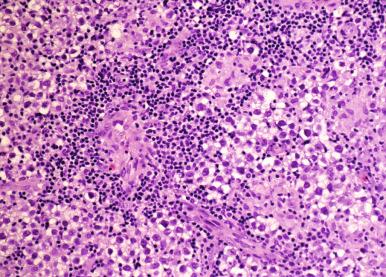
In addition to histologic features and patient demographic data, the location of an involved lymph node can narrow the possible sources of a metastatic tumor. In cervical lymph nodes, the most commonly encountered occult tumor is squamous cell carcinoma or undifferentiated carcinoma from a head or neck primary tumor. The primary site can be located in approximately 40% of these cases by subsequent clinical examination and is usually at the base of the tongue or tonsillar fossa. Survival is determined by the extent of lymph node involvement at presentation. Occult carcinomas originating in the lung and esophagus are the next most commonly encountered metastatic tumors in cervical lymph nodes.
In patients with supraclavicular lymphadenopathy as a result of metastasis, carcinoma is the most common pathologic finding. Tumors of abdominal origin preferentially result in left supraclavicular (Virchow's) lymph node enlargement, whereas tumors of the head and neck, lung, and breast (as well as lymphomas) can involve either side. Metastatic tumors in axillary lymph nodes most often originate in the breast in women, followed in frequency by melanoma, cutaneous squamous cell carcinoma, and lung cancers. In inguinal lymph nodes, the most common metastatic tumors are melanoma and prostate carcinoma in men and gynecologic malignancies in women. Germ cell tumors, mostly seminoma, can present as metastases involving retroperitoneal lymph nodes and are frequently extensively necrotic.
Immunohistochemical stains for metastatic tumors are divided into those used for diagnosis and those used for prognostic or treatment purposes. A review of the prognostic markers is beyond the scope of this chapter, and they are constantly evolving. Suggested diagnostic immunohistochemistry panels for different tumor categories are shown in Table 59-2 .
| Histologic Group | First Round of Staining | Second and Third Rounds of Staining |
|---|---|---|
| Small-cell tumors | Pan-keratin, TdT, LCA, desmin | Chromogranin, synaptophysin, CD56, CD34, CD99, lymphoid markers, myogenin, myo-D1, myf-4, calcitonin |
| Anaplastic and epithelioid tumors | Pan-keratin, S-100, CD30, LCA | EMA, PLAP, immunoglobulins, HMB45, melan A, CD68, myeloperoxidase |
| Spindle cell tumors | Smooth muscle actin, desmin, S-100, pan-keratin | HHF35 actin, CD117/c-KIT, LCA, caldesmon, CD21 or CD35 (FDC sarcoma) |
In general, the commonly used first-tier diagnostic antibodies are highly specific but variably sensitive for the detection of particular tumor types. However, aberrant or unrecognized patterns of staining with routine antibodies must always be considered. Most hematopoietic markers in common use are specific for hematopoietic cells, but some hematopoietic markers, such as CD5, CD7, CD10, CD43, and CD56, are commonly expressed in neuroendocrine tumors or carcinomas from certain sites. Also, CD30 is strongly expressed by embryonal germ cell tumors and sometimes by mesotheliomas, and CD45 (leukocyte common antigen [LCA]) may be positive in the cytoplasm of breast carcinoma, for example, with rare membranous positivity in poorly differentiated carcinomas. Conversely, S-100 protein and the vascular marker CD31 are variably expressed by monocytes and macrophages. VS38, CD138/syndecan-1, and CD38 are plasma cell markers. However, VS38 and CD138/syndecan-1 are expressed by many solid tumors, whereas CD38 is more restricted to plasma cells and some lymphocytes and histiocytes. Finally, plasmacytomas are notorious for aberrant and false-positive immunoreactivity and can stain for cytokeratin, myeloperoxidase, and T-cell markers, among others.
In metastatic carcinoma of unknown origin, a second group of immunostains can complement the histologic appearance and clinical data, suggesting a possible primary site. Currently, the most broadly useful antibodies are those that detect the cytokeratin expression pattern, particularly keratin types 7 and 20 ( Fig. 59-6 ). The overall patterns of these markers are summarized in Table 59-3 , but it is important to note that variations can be seen among the more poorly differentiated tumors. Other markers can be helpful in identifying metastasis from less common primary sites. For example, hepatocellular carcinoma is typically negative for keratin 19 (in contrast to cholangiocarcinoma) but positive for low-molecular-weight keratin, as detected by CAM5.2. The pattern of keratin positivity can also be helpful. A punctate or dotlike cytoplasmic staining pattern observed in Merkel cell carcinoma and small-cell carcinoma is characteristic but not completely specific for these tumor types. It should be noted that some lymphomas (approximately 2%) of both mature and lymphoblastic types can show some keratin positivity, most commonly cytokeratin 8.
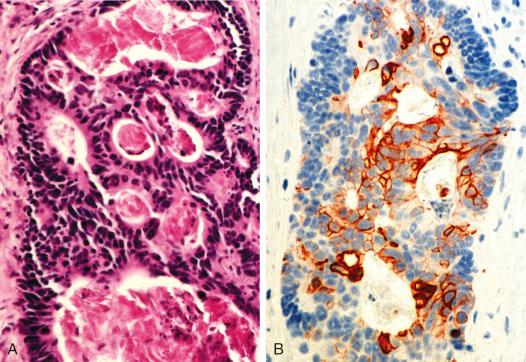
| Marker | Specificity |
|---|---|
| Arginase | Arginase |
| Beta-catenin | GI tract, ovarian |
| CDX2 | GI tract |
| Calcitonin | Medullary thyroid carcinoma; rarely, other neuroendocrine tumors |
| Chromogranin | Neuroendocrine differentiation, including small-cell and Merkel cell carcinomas |
| Cytokeratin 7 + , 20 − | Lung, breast, transitional cell, ovarian, some neuroendocrine and squamous cell carcinomas; endometrioid ovarian |
| Cytokeratin 7 − , 20 + | GI tract, mucinous ovarian, Merkel cell |
| Cytokeratin 7 + , 20 + | Transitional cell (bladder), cholangiocarcinoma |
| Cytokeratin 7 − , 20 − | Adrenocortical, hepatocellular, prostate, renal cell, small-cell carcinoma, squamous cell (esophageal), carcinoid, germ cell tumor |
| Fli-1 | Ewing's sarcoma, vascular tumors |
| GATA3 | Breast, salivary gland, urothelial tumors |
| GCDFP-15 | Breast, salivary gland, some prostate tumors |
| HepPar1 | Hepatocellular carcinoma, small subset (≈5%) of other adenocarcinomas and neuroendrocrine tumors |
| HMB45 | Melanoma, lymphangiomyomatosis |
| MART-1/melan A | Melanoma, adrenocortical carcinoma, other steroid-producing tumors |
| Napsin A | Lung adenocarcinoma, papillary renal cell carcinoma |
| Oct-4 | Seminoma and embryonal carcinomas of testis |
| P63 and/or p40 | Squamous cell carcinoma, urothelial carcinoma |
| PAP | Prostate, some carcinoids, apocrine breast and salivary tumors |
| PAX8 | Endometrial adenocarcinoma, ovarian serous, renal cell carcinoma, thyroid carcinomas |
| PLAP | Germ cell tumors; occasional carcinomas of lung, GI, and Müllerian origin; some histiocytes |
| Podoplanin/D2-40 | Kaposi's sarcoma, some angiosarcomas, lymphangioma |
| PSA | Prostate carcinoma (decreased in poorly differentiated tumors), some breast carcinomas |
| pVHL | Renal clear cell as well as clear cell of ovary and uterus |
| RCC | Renal cell carcinomas |
| Surfactant A | Lung adenocarcinomas |
| Synaptophysin | Neuroendocrine differentiation, including small-cell and Merkel cell carcinomas |
| Thyroglobulin | Thyroid tumors (not anaplastic or mucoepidermoid) |
| TTF-1 | Lung and thyroid carcinomas and neuroendocrine tumors at these sites |
| Villin | GI tumors (brush border–type staining) |
| Vimentin | Negative in endometrial and low-grade renal carcinomas, positive in most other carcinomas |
The complex pattern of immunohistochemical expression of the classic serum tumor markers, including carcinoembryonic antigen (CEA), CA19-9, CA15-3, CA125, epithelial membrane antigen/MUC1, β-human chorionic gonadotropin, and alpha fetoprotein, limits their role as diagnostic markers except in particular cases (e.g., canalicular CEA staining detected by polyclonal antiserum in hepatocellular carcinoma). Similarly, polypeptide hormones and their receptors, such as testosterone, estrogen, and progesterone receptors, can be expressed by a wide variety of carcinomas and should be used cautiously as evidence of a particular cell lineage.
Molecular profiling with a limited array of transcripts of lineage-associated genes has recently shown great promise in accurate classification and the selection of appropriate therapies. Cytogenetic analysis, although technically demanding, can be highly useful in evaluating the poorly differentiated blastoid tumors; there are characteristic translocations that support the diagnosis of lymphoblastic lymphoma, neuroblastoma, rhabdomyosarcoma, Ewing's sarcoma, and other sarcoma types. Targeted fluorescence in situ hybridization (FISH) analysis for specific chromosomal translocations can routinely be performed on cytologic smears and touch imprints, with high sensitivity. Although less sensitive, FISH is frequently done on fixed, paraffin-embedded tissue sections as well. Electron microscopy has a limited role in the differential diagnosis but can be helpful in the definitive diagnosis of poorly differentiated tumors, for example, by detecting melanosomes in poorly differentiated melanoma or cell junctions that would suggest a carcinoma or dendritic cell neoplasm. In small-cell tumors, electron microscopy is especially useful in detecting muscle filaments in rhabdomyosarcoma.
Two current molecular assays for identifying a tumor of uncertain origin are based on gene-expression profiling by detecting messenger RNA (mRNA) or microRNA. CancerTYPE ID (BioTheranostics, San Diego, Calif.) is based on 92 gene classifier (87 tumor-associated genes and 5 reference genes) real time reverse transcription polymerase chain reaction (RT-PCR) for detecting mRNA from frozen or paraffin tissue samples and is reported to have a diagnostic accuracy of approximately 80% to 90%. Rosetta Genomics (Philadelphia, Pa.) uses RT-PCR to detect 64 microRNAs from paraffin tissue samples to detect 49 cancer origins, with a reported accuracy of more than 80%.
In several neoplasms, the density of tumor-associated reactive lymphocytes can obscure the tumor cells. This is particularly common in seminoma, melanoma, and medullary carcinoma of the breast. In mediastinal biopsy specimens, thymoma should always be a diagnostic consideration when numerous small lymphocytes are associated with a spindle cell or epithelioid cell proliferation. The diagnosis of thymoma can be further complicated by the immature thymic immunophenotype of the reactive T-cell component, which can be indistinguishable from lymphoblastic lymphoma by flow-cytometric analysis. In such cases, immunostains can easily detect the extensive cytokeratin-positive tumor meshwork.
Undifferentiated nasopharyngeal carcinoma (or undifferentiated carcinoma arising at other sites, such as urothelial tumors) is probably the solid tumor most frequently misdiagnosed as lymphoma. This is due to its occasionally prominent inflammatory component and the fact that occult nodal presentations of nasopharyngeal carcinoma are common, occurring in up to 50% of cases. The keratinizing and non-keratinizing squamous cell variants of nasopharyngeal carcinoma usually present few diagnostic difficulties ( Fig. 59-7 ). However, in the lymphoepithelioma variant of undifferentiated nasopharyngeal carcinoma (also known as the Schmincke type), the neoplastic cells are often obscured by a dense lymphocyte infiltrate ( Fig. 59-8 ). Other cases can be associated with numerous neutrophils and eosinophils and may mimic Hodgkin's lymphoma ( Fig. 59-9 ). Tumor cell cohesiveness and central necrosis within tumor cell aggregates are helpful clues. The most useful ancillary tests for the diagnosis of nasopharyngeal and undifferentiated carcinoma are keratin immunostains and in situ hybridization for Epstein-Barr virus sequences with Epstein-Barr virus–encoded small RNA (EBER) probes.
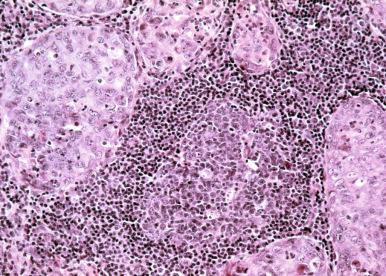
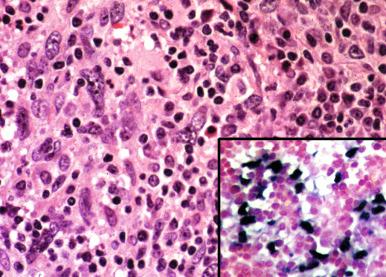
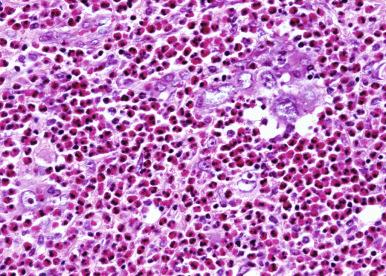
Become a Clinical Tree membership for Full access and enjoy Unlimited articles
If you are a member. Log in here